In 1821, the upper storey of 18 Bondgate was used as a place of worship by the newly formed Society of Independents, now the United Reformed Church. In 1825, the whole building became the Bowling Green Inn. The inn’s earliest recorded licensees are Hannah Cawood in 1829 and Joseph Mallinson in 1834. Much more recently, Trevor and Judith Wallis ended their time at the Bowling Green, auctioning their numerous collectables previously on display inside the pub. The collection included a full-size crocodile and other stuffed animals, clocks, musical instruments and propellers.
A plaque documenting the history of The Bowling Green.
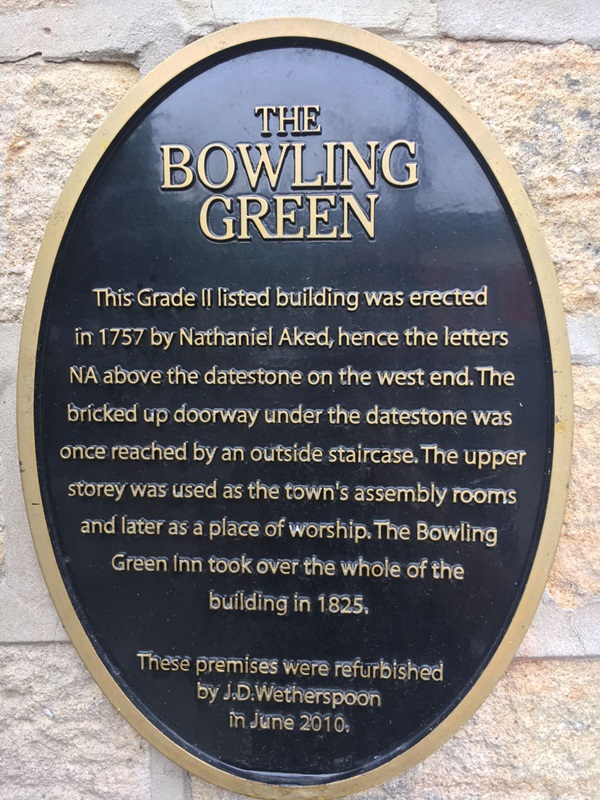
The plaque reads: This grade II listed building was erected in 1757 by Nathaniel Aked, hence the letters NA above the datestone on the west end. The bricked up doorway under the datestone was once reached by an outside staircase. The upper storey was used as the town’s assembly rooms and later as a place of worship. The Bowling Green Inn took over the whole of the building in 1825.
Prints and text about Otley’s market.
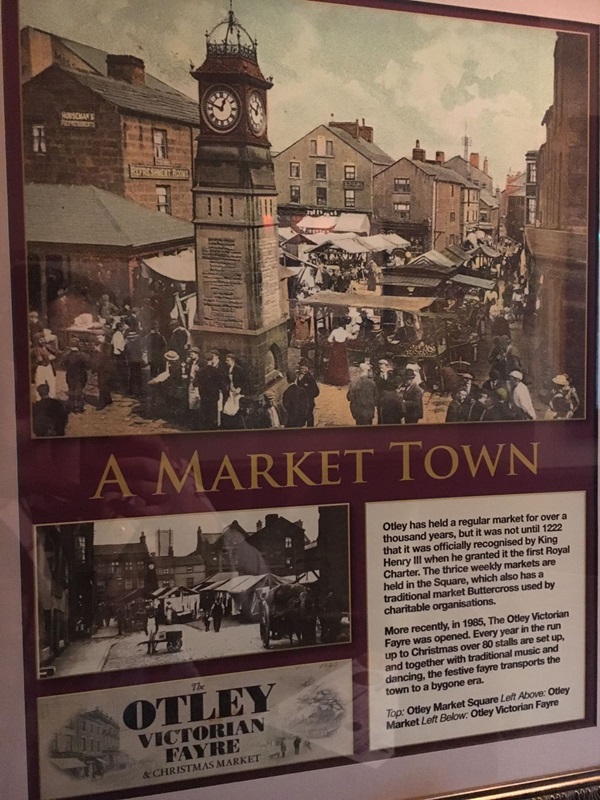
The text reads: Otley has held a regular market for over a thousand years, but it was not until 1222 that it was officially recognised by King Henry III when he granted it the first Royal Charter. The thrice weekly markets are held in the square, which also had a traditional market Buttercross used by charitable organisations.
More recently, in 1985, the Otley Victorian Fayre was opened. Every year in the run up to Christmas over 80 stalls are set up, and together with traditional music and dancing, the festive fayre transports the town to a bygone era.
Top: Otley Market Square
Left above: Otley Market
Left below: Otley Victorian Fayre.
Photographs and text about the Jubilee Clock.
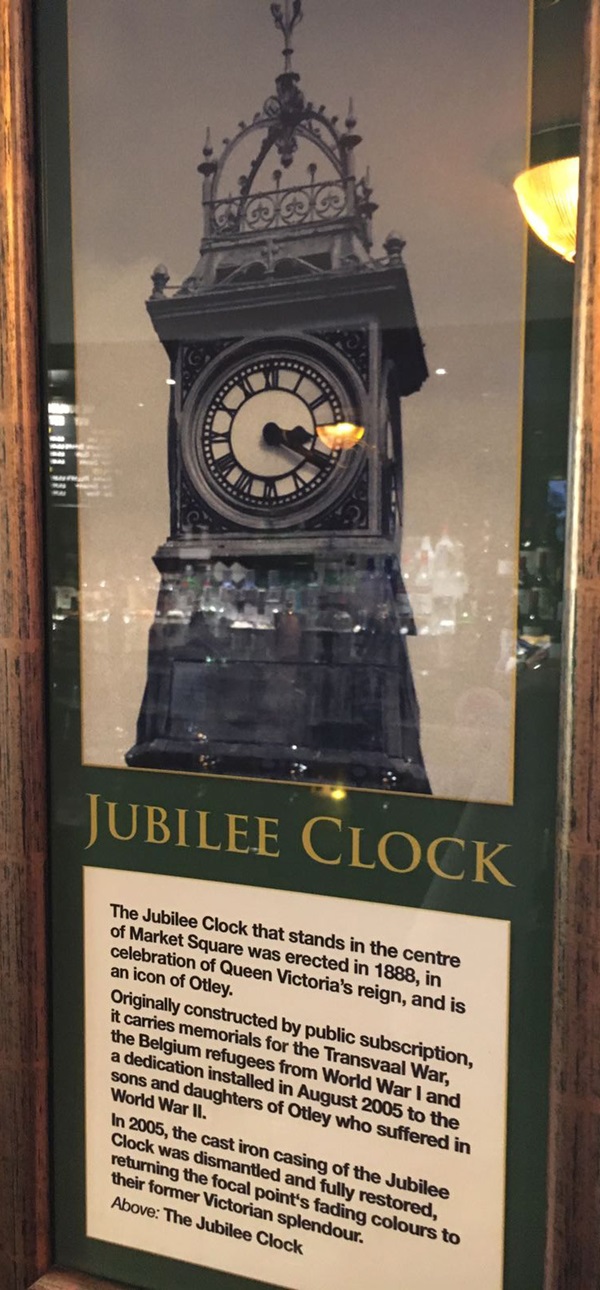
The text reads: The Jubilee Clock that stands in the centre of Market Square was erected in 1888, in celebration of Queen Victoria’s reign, and is an icon of Otley.
Originally constructed by public subscription, it carries memorials for the Transvaal War, the Belgium refugees from World War I and a dedication installed in August 2005 to the sons and daughters of Otley who suffered in World War II.
In 2005 the cast iron casing of the Jubilee Clock was dismantled and fully restored, returning the focal points fading colours to their former Victorian splendour.
Above: The Jubilee Clock.
Photographs and text about businesses in Otley.
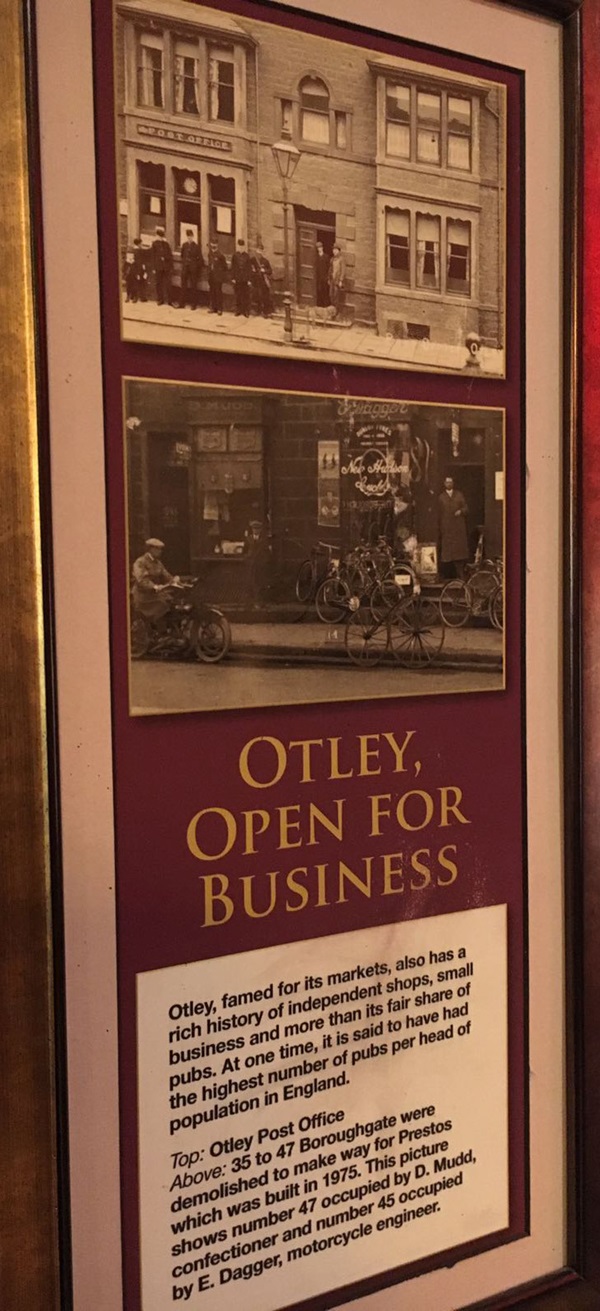
The text reads: Otley, famed for its markets also has a rich history of independent shops, small businesses and more than its fair share of pubs. At one time, it is said to have had the highest number of pubs per head of population in England.
Top: Otley post office
Above: 35 to 47 Boroughgate were demolished to make way for Prestos which was built in 1975. This picture show number 47 occupied by D Mudd, confectioner and number 45 occupied by E Dagger, motorcycle engineer.
Prints and text about Otley Railway Station.
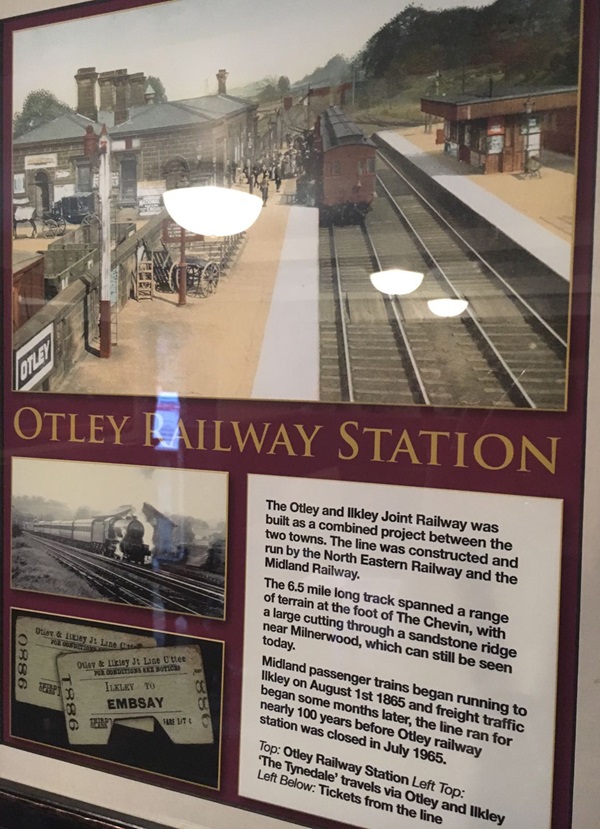
The text reads: The Otley and Ilkley Joint Railway was built as a combined project between the two towns. The line was constructed and run by the North Eastern Railway and the Midland Railway.
The 6.5 mile long track spanned a range of terrain at the foot of The Chevin, with a large cutting through a sandstone ridge near Milnerwood, which can still be seen today.
Midland passenger trains began running to Ilkley on August 1 1865 and freight traffic began some months later, the line ran for nearly 100 years before Otley Railway Station was closed in July 1965.
Top: Otley Railway Station
Left top: The Tynedale travels via Otley and Ilkley
Left below: Tickets from the line.
Illustrations and text about Edmund Kean.
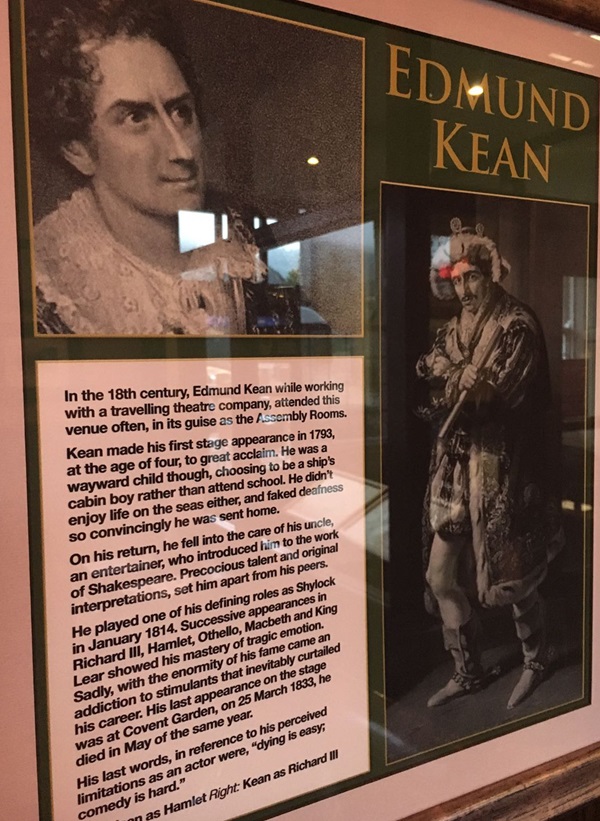
The text reads: In the 18th century, Edmund Kean while working with a travelling theatre company, attended this venue often, in its guise as the Assembly Rooms.
Kean made his first stage appearance in 1793, at the age of four, to great acclaim. He was a wayward child though, choosing to be a ship’s cabin boy rather than attend school. He didn’t enjoy life on the seas either, and faked deafness so convincingly he was sent home.
On his return, he fell into the care of his uncle, an entertainer, who introduced him to the work of Shakespeare. Precocious talent and original interpretations set him apart from his peers.
He played one of his defining roles as Shylock in January 1814. Successive appearances in Richard III, Hamlet, Othello, Macbeth and King Lear showed his mastery of tragic emotion. Sadly, with the enormity of his fame came an addition to stimulants that inevitably curtailed his career. His last appearance on the stage was at Covent Garden, on 25 March 1833, he died in May of the same year.
His last words, in reference to his perceived limitations as an actor were, “dying is easy; comedy is hard”.
Above: Kean as Hamlet
Right: Kean as Richard III.
An illustration and text about John Wesley.
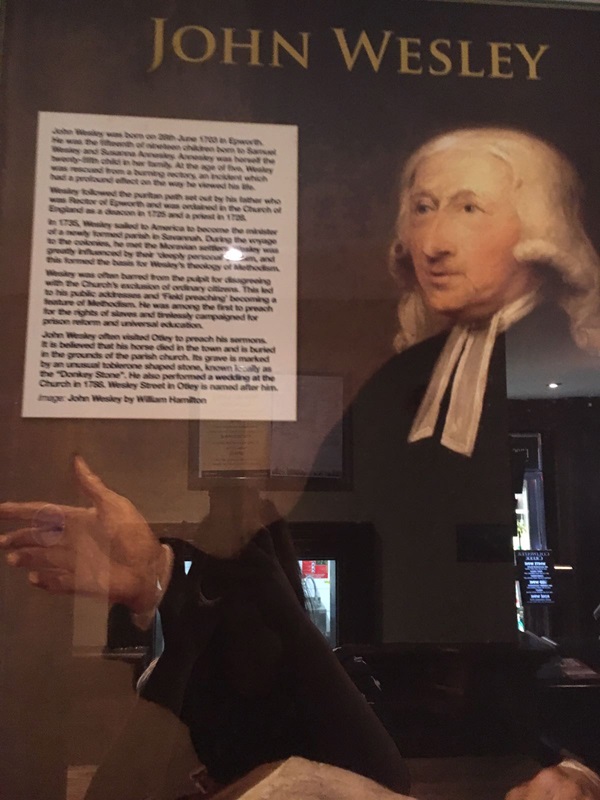
The text reads: John Wesley was born on 28 June 1703 in Epsworth. He was the fifteenth of nineteen children born to Samuel Wesley and Susanna Annesley. Annesley was herself the twenty fifth child in her family. At the age of five, Wesley was rescued from a burning rectory, an incident which had a profound effect on the way he viewed his life.
Wesley followed the puritan path set out by his father who was Rector of Epworth and was ordained in the Church of England as a deacon in 1725 and a priest in 1728.
In 1735, Wesley sailed to America to become the minister of a newly formed parish in Savannah. During the voyage to the colonies, he met the Moravin settlers. Wesley was greatly influenced by their deeply personal pietism, and this formed the basis for Wesley’s theology of Methodism.
Wesley was often barred from the pulpit for disagreeing with the Church’s exclusion of ordinary citizens. This led to his public addresses and ‘Field Preaching’ becoming a feature of Methodism. He was among the first to preach for the rights of slaves and tirelessly campaigned for prison reform and universal education.
John Wesley often visited Otley to preach his sermons. It is believed that his horse died in the town and is buried in the ground of the parish church. Its grace is marked by an unusual toblerone shaped stone, known locally as the ‘Donkey Stone’. He also performed a wedding at the church in 1788. Wesley Street in Otley is named after him.
Image: John Wesley by William Hamilton.
Photographs and text about Wharfemeadows Park.
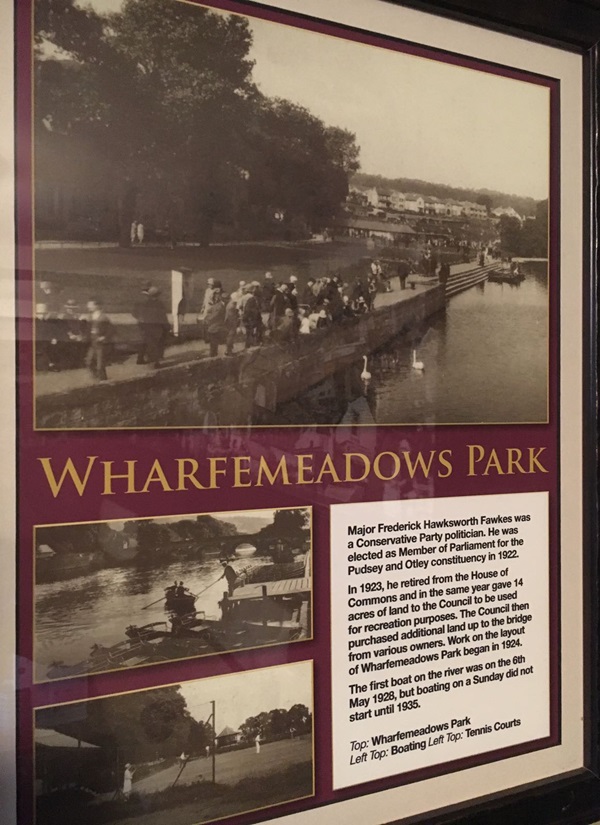
The text reads: Major Frederick Hawksworth Fawkes was a Conservative Party politician. He was elected as Member of Parliament for the Pudsey and Otley constituency in 1922.
In 1923, he retired from the House of Commons and in the same year gave 14 acres of land to the council to be used for recreation purposes. The council then purchased additional land up to the bridge from various owners. Work on the layout of Wharfemeadows Park bean in 1924. The first boat on the river was on the 6 May 1928, but boating on a Sunday did not start until 1935.
Photographs and text about Thomas Chippendale.
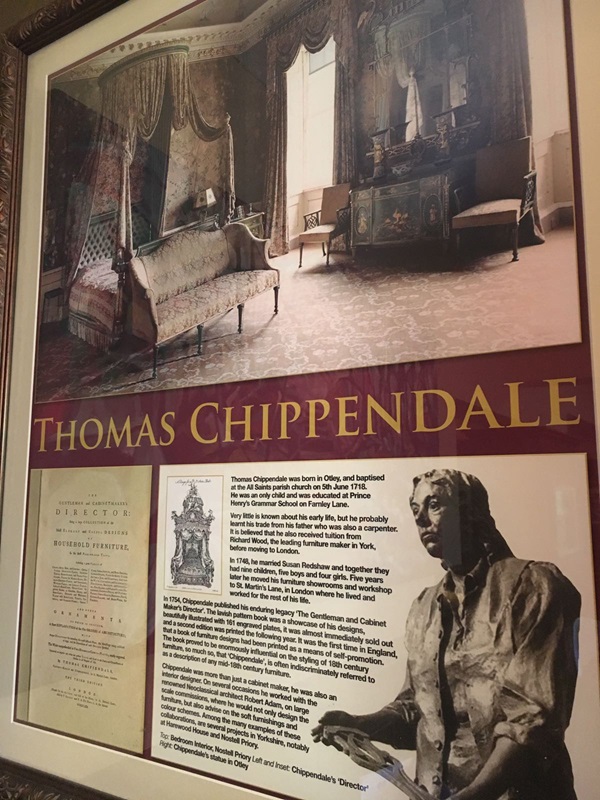
The text reads: Thomas Chippendale was born in Otley, and baptised at the All Saints parish church on 5 June 1718. He was an only child and was educated at Prince Henry’s Grammar School on Farnley Lane.
Very little is known about his early life, but he probably learnt his trade from his father who was also a carpenter. It is believed that he also received tuition from Richard Wood, the leading furniture maker in York, before moving to London.
In 1748, he married Susan Redshaw and together they had nine children, five boys and four girls. Five years later he moved his furniture showrooms and workshop to St. Martin’s Lane, in London where he lived and worked for the rest of his life.
In 1754, Chippendale published his enduring legacy The Gentleman and Cabinet Maker’s Director. The lavish pattern book was a showcase of his designs, beautifully illustrated with 161 engraved plates, it was almost immediately sold out and a second edition was printed the following year. It was the first time in England, that a book of furniture designs had been printed as a means of self-promotion. The book proved to be enormously influential on the styling of 18th century furniture, so much so, that Chippendale is often indiscriminately referred to as a description of any mid 18th century furniture.
Chippendale was more than just a cabinet maker, he was also an interior designer. On several occasions he worked with the renowned Neoclassical architect Robert Adam, on large scale commissions, where he would not only design the furniture, but also advise on the soft furnishings and colour schemes. Among the many examples of these collaborations, are several projects in Yorkshire, notably at Harewood House and Nostell Priory.
Illustrations and text about JMW Turner.
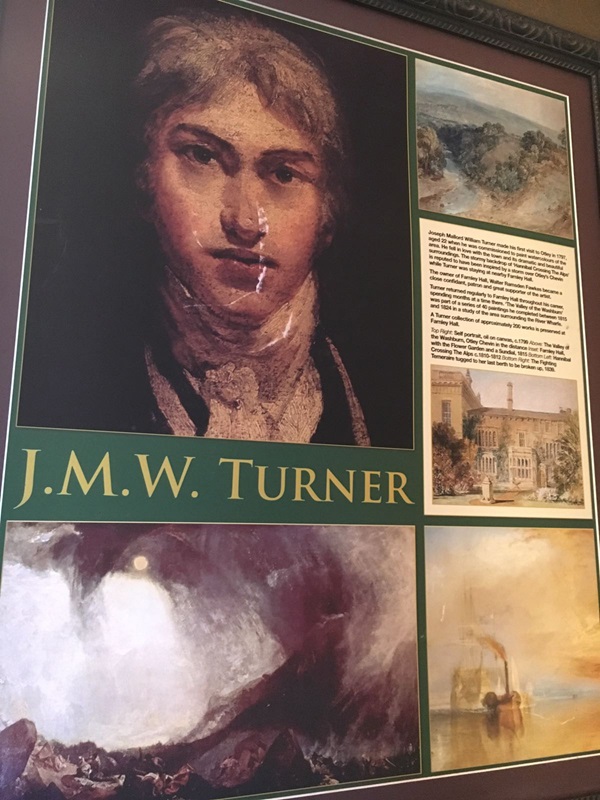
The text reads: Joseph Mallord William Turner made his first visit to Otley in 1797, aged 22 when he was commissioned to paint watercolours of the area. He fell in love with the town and its dramatic and beautiful surroundings. The stormy backdrop of Hannibal Crossing the Alps is reputed to have been inspired by a storm over Otley’s Chevin while Turner was staying at nearby Farnley Hall.
The owner of Farnley Hall. Walter Ramsden Fawkes became a close confidant, patron and great supporter of the artist.
Turner returned regularly to Farnley Hall throughout his career, spending months at a time there. The Valley of the Washburn was part of a series of 40 paintings he completed between 1815 and 1824 in a study of the area surrounding the River Wharfe.
A Turner collection of approximately 200 works is preserved at Farnley Hall.
Illustrations and text about Newhall Old Hall.
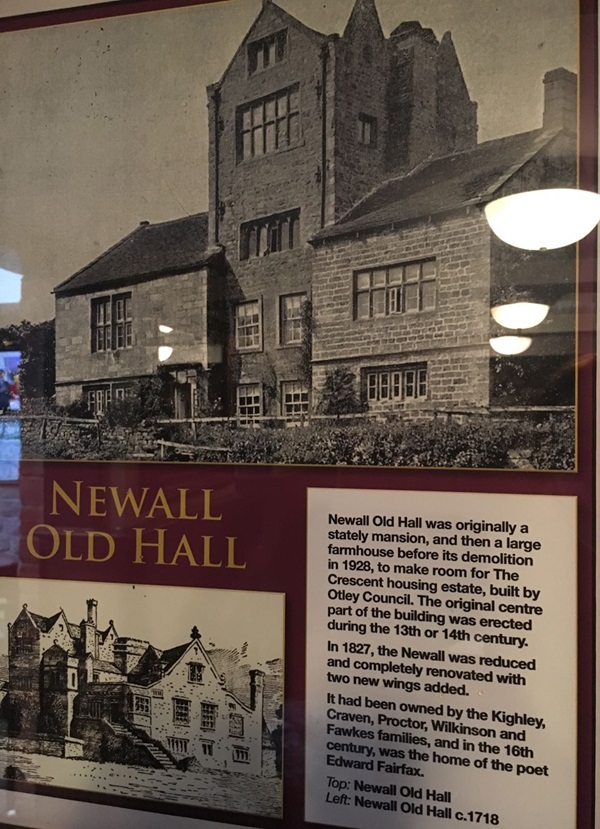
The text reads: Newall Old Hall was originally a stately mansion, and then a large farmhouse before its demolition in 1928, to make room for The Crescent housing estate, built by Otley Council. The original centre part of the building was erected during the 13th and 14th century.
In 1827, the Newall was reduced and completely renovated with two new wings added.
It had been owned by the Kighley, Craven, Proctor, Wilkinson and Fawkes families, and in the 16th century, was the home of the poet Edward Fairfax.
Posters and text about the Wharfedale.
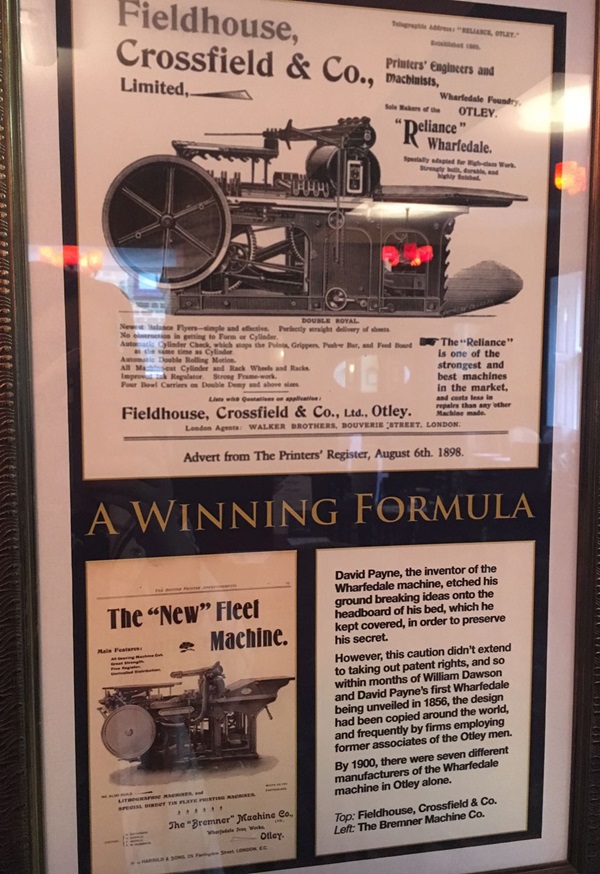
The text reads: David Payne, the inventor of the Wharfedale machine, etched his ground breaking ideas onto the headboard of his bed, which he kept covered, in order to preserve his secret.
However, this caution didn’t extend to taking out patent rights, and so within months of William Dawson and David Payne’s first Wharfedale being unveiled in 1856, the design had been copied around the world, and frequently by firms employing former associates of the Otley men.
By 1900, there were seven different manufacturers of the Wharfedale machine in Otley alone.
An historical plaque placed on the building by Otley Town Council.
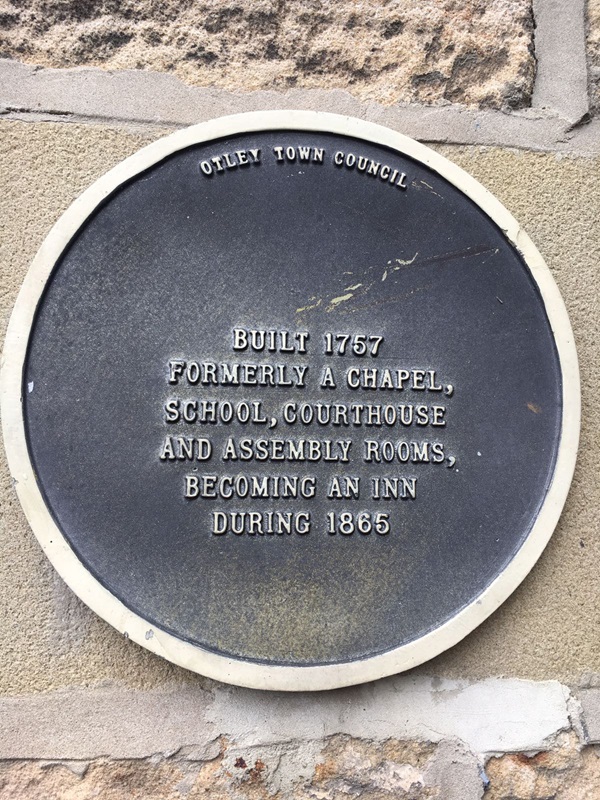
The plaque reads: Built in 1757 formerly a chapel, school and courthouse and assembly rooms, becoming an inn during 1865.
External photograph of the building – main entrance.
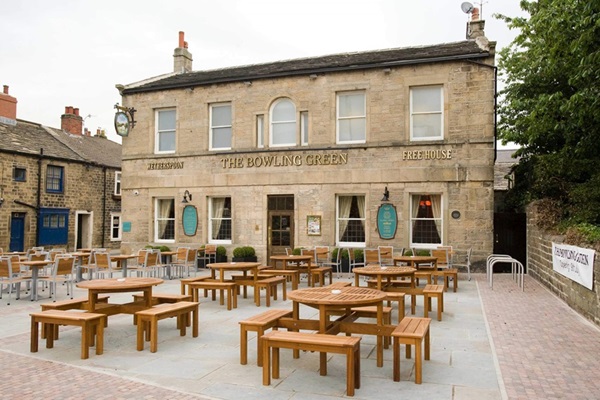
If you have information on the history of this pub, then we’d like you to share it with us. Please e-mail all information to: pubhistories@jdwetherspoon.co.uk